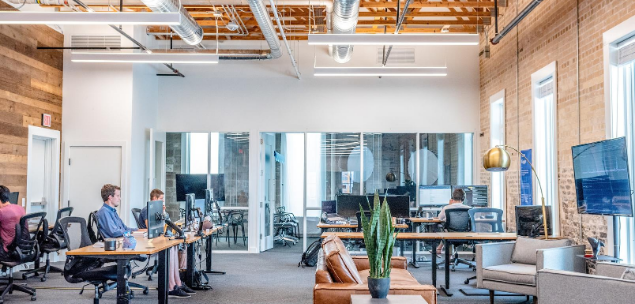Many businesses are unsure about whether they should ask employees to return to the workplace. We’ve taken a look at the different approaches that some companies have taken.
What are some of the current approaches to returning to the workplace?
Marie-Anne Lampotang, General Manager at Stone & Chalk in Sydney, noted that many start ups had already started coming back into Stone & Chalk’s collaborative workplaces.
“A lot of start ups have transitioned back to work. They’re doing it in a number of ways: coming different days, coming only if people want to come in … there’s nothing mandated. The number one issue start ups are concerned about is actually public transport.”
She also emphasised the importance of safety. “It is full security at the moment. There’s no random people coming in and we make sure people comply to social distancing rules which is particularly important in enclosed spaces such as meeting rooms.”
Nevertheless many start ups were still largely working from home. “There’s plenty of room for those who are coming right now and we’re not really at the stage where overcrowding is an issue. Most people who come in are happy to find there’s a lot of space and they’re not cramped.”
Moreover, social distancing rules have meant that personal connections have dwindled, making it harder for start ups to make the connections that are crucial to their success.
“We’ve got a lot of in-person gatherings that can’t happen anymore. Those accidental collisions when people meet … they don’t happen when you don’t see people.
“We’re working harder than before to engineer these connections. We’re not just a collaborative environment, we help with connections and networks to help these start ups grow.”
However for many companies, the workplace is an indispensable part of their business model. Cibby Pulikkaseril, Founder and CTO at Baraja, put in place a rotating schedule for his business to ensure that both employee safety and customer demands could be met.
“When coronavirus hit, many other start ups started doing 100 per cent [work] from home. It wasn’t an option for us because we make laser sensors for self driving cars and most of the work was in hardware.
“You can work from home for a couple days, but without hardware you can’t make progress. We also ship parts to customers and so without a team on site we’d let down customers.
“So we set up isolated shifts. We split the company into three teams. Red and blue for office workers. Half of your team would be in the office and half [would be at work] at home, and then the next week you’d switch over. Every night we have a thorough clean.
“For manufacturing we have a green team. They are isolated from the other half by space. They work downstairs in the office and the other staff in red and blue teams cannot go down. All deliveries and parcels are handled through the lift.”
Should employees be allowed to work from home forever?
Companies such as Atlassian announced that employees had the option to work from home indefinitely. To combat uncertainties during the pandemic, Atlassian announced their “TEAM Anywhere” program where employees were given the option to work from home forever.
Speaking at a virtual panel with Slack CEO Stewart Butterfield, Atlassian CEO Mike Cannon-Brookes described COVID-19 as “the world’s largest telecommunications experience”.
“The genesis of [TEAM Anywhere] … is that we need to change how we work and where we work. We need to separate these two concepts.
“People often combine them. If you think about that, how do you have a meeting? You walk into the same room together. You’ve said where we work is going to drive how we work. We need to firstly change how we work, in order to enable people to work where they want.
“So our policy’s been very clear about communicating to employees and giving as much notice as possible that where you work is going to be up to you … but how we work has to be standardised.”
If you decide to return to the workplace, what else do employers need to keep in mind?
- Make your workplace safe
When deciding to return to work, employers must have a safe and healthy workplace. To help plan this, the National COVID-19 Coordination Commission has an online planning tool to help employers.
If an employee has symptoms, the employer must direct the employee to not work or to work from home and ask the employee to seek medical advice.
- Keep up-to-date with your state or territory’s government directions
Individual states and territories have their own government directions on asking employees to return to work or to return to the workplace.
Employers can direct employees to work normal hours if it is reasonable to do so (excluding employees on approved leave). Ordinary work health and safety and legal obligations will still apply. Employees can refuse to return to work if workplaces have inadequate safety precautions.
If employers wish to ask employees on Jobkeeper to return to work, an employer can lift the previous stand down direction or replace it with a different stand down arrangement.
- Understand what duties you can ask your employee to perform
Employers may need to change an employee’s usual duties when returning to the workplace. This must comply with any applicable award, agreement or employment contract.
If these duties are not a part of the employee’s usual duties, they must be within an employee’s skill and competency.
For more information, see https://coronavirus.fairwork.gov.au/coronavirus-and-australian-workplace-laws/returning-to-work-and-the-workplace.
Keep up to date with our stories on LinkedIn, Twitter, Facebook and Instagram.

